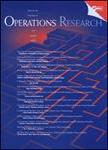版权所有:内蒙古大学图书馆 技术提供:维普资讯• 智图
内蒙古自治区呼和浩特市赛罕区大学西街235号 邮编: 010021

作者机构:Univ Calif Berkeley Dept Ind Engn & Operat Res Walter A Haas Sch Business Berkeley CA 94720 USA
出 版 物:《OPERATIONS RESEARCH》 (运筹学)
年 卷 期:2003年第51卷第5期
页 面:785-797页
核心收录:
学科分类:1201[管理学-管理科学与工程(可授管理学、工学学位)] 07[理学] 070104[理学-应用数学] 0701[理学-数学]
主 题:Programming: integer algorithms optimization in integers Network/graphs: flow algorithms parametric minimum cut Mathematics: convexity convex optimization problem
摘 要:The inverse spanning-tree problem is to modify edge weights in a graph so that a given tree T is a minimum spanning tree. The objective is to minimize the cost of the deviation. The cost of deviation is typically a convex function. We propose algorithms here that are faster than all known algorithms for the problem. Our algorithm s run time for any convex inverse spanning-tree problem is O(nm log(2) n) for a graph on n nodes and m edges plus the time required to find the minima of the n convex deviation functions. This not only improves on the complexity of previously known algorithms for the general problem, but also for algorithms devised for special cases. For the case when the objective is weighted absolute deviation, Sokkalingam et al. (1999) devised an algorithm with run time O(n(2)m log(nC)) for C the maximum edge weight. For the sum of absolute deviations our algorithm runs in time O(n(2) log n), matching the run time of a recent (Ahuja and Orlin 2000) improvement for this case. A new algorithm for bipartite matching in path graphs is reported here with complexity of O(n(1.5) log n). This leads to a second algorithm for the sum of absolute deviations running in O(n(1.5) log n log C) steps.